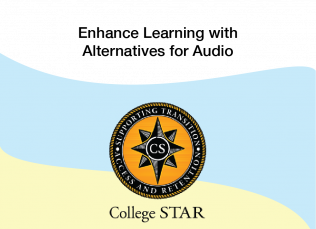
Enhance Learning with Alternatives for Audio
This module will address strategies for providing alternative options for auditory content (i.e., closed captions, transcripts) as a way for instructors to proactively support learners and enhance their learning experience. These strategies are relevant whether instructors teach using fully asynchronous online courses, blended learning experiences, or simply use audio/video materials in or out of class.
This resource was originally developed with resources from the College STAR grant. That grant has ended and the College STAR modules will now permanently reside at the East Carolina University Office for Faculty Excellence.
Module Introduction
While it is inherently clear that people with auditory disabilities (e.g., deaf, hard of hearing) and other relevant disabilities (e.g., auditory processing disorders) would benefit from having alternative options for audio, many people are unaware of how powerful such options may be for all learners, including college students without disabilities.
For example, in their 2016 study, Dallas, McCarthy, and Long found in their longitudinal study that students who were provided access to captioning for videos used for instruction outperformed peers who covered the same content in the same context without captions in terms of information recall and grades. Importantly, Dallas and colleagues also noted that the presence of captions had no negative impact, which has implications for showing videos (with captions) live in class. Gernsbacher, in her (2015) review of the literature, additionally highlights the substantial gains text-based options for audio provide for English language learners (language development as well as content comprehension) and college students with and without disabilities (with benefits including gains in attention, retention, and comprehension for everyone).
This module will address strategies for providing alternative options for auditory content (i.e., closed captions, transcripts) as a way for instructors to proactively support learners and enhance their learning experience through video and audio content. These strategies are relevant whether instructors teach using fully asynchronous online courses, blended learning experiences, or simply use audio/video materials in or out of class.
Support for this Module
Original development of this module was made possible by the College STAR (Supporting Transition Access and Retention) initiative. College STAR was a grant-funded project focused on partnering postsecondary educational professionals and students to learn ways for helping postsecondary campuses become more welcoming of students with learning and attention differences. Much of this work was made possible by generous funding from the Oak Foundation.
Organization/Publishers:
Share this resource:
Posted date:
November 10, 2022
